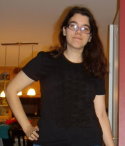I was about seventeen when I learned that most people put on their socks with two hands. It probably sounds ludicrous but it’s true: my aunt was visiting and we were about to head out for something so I was getting my socks and shoes on. She looked at me a bit oddly and asked, “How do you do that?” I had no idea what she was talking about and she explained that she meant my socks, which I’d just slipped on like I always did, stretched wide with thumb and forefinger and then guided over my toes. I don’t remember exactly how I answered her but the general gist of my reply was, “What? Doesn’t everyone do it this way?”
That story highlights for me one of the differences in the way I (and, if I may be permitted to generalize, at least some other Hemi-Kids as well) see myself versus the way the world sees us. I know I’m preaching to the choir here, as many of you are parents of these kids and you’ve seen first-hand how adept we can be at taking on a physically challenging world, but bear with me and I’ll see if I can make it worth your while.
The key here is adaptation versus innovation. Adaptations are easier to explain so I’ll get into that first. An adaptation is something that I’ve seen someone else do, that I want or need to do, that I try (and try, and bullheadedly try) until I find a modified way to accomplish it. Big ones for me were tying my shoes (which I learned in second grade and still do clumsily), using a pair of scissors (still can’t cut straight), and zipping a zipper on a jacket (all of my jackets now either button or just slip over my head). I don’t want to imply there are no adaptations I do well – I can type one-handed faster than most people can type with two – my point is that adaptations are things I learned from other people, the way they do them or as close to it as I can get.
Innovations, on the other hand, are the fun ones. They’re things that I do, that I taught myself, that are nothing like the ‘typical’ way to do it and come easily to me. They don’t require sustained effort, they don’t require a lot of thought, and they’re just like any other simple day-to-day task. My parents gasp and flinch when I carry four glasses to the table in my right hand but to me it’s natural and I know I’m not going to drop them. I still get a little confused when I crack an egg one-handed and people think it’s this great feat. That’s the thing about innovations; we figure out new ways to perform tasks without even knowing we’re doing it.
Where adaptation is hard, innovation is as natural as breathing. Adaptation takes effort; innovation is nearly unconscious. I wish I could give you more examples but I’m not entirely sure where my innovations lie, as I don’t recognize them until other people point them out. I tend to think everyone does it that way until I’m told they don’t. I’m absolutely certain your child has innovations as well; you might even know what they are.
I guess what I’m trying to get at here is that I want you to have hope. Your child faces a very difficult journey, that’s undeniable, but it’s not always as hard for us as it seems. We’re not just adapting to an often-unfriendly world, we’re innovating creative solutions for problems without even realizing it. We will carry that creativity and innate instinct to look at problems from new angles, to think outside the box for solutions that most people would never find, into our schools and our careers. We will lead the field in innovative thinking because we are born innovators.
For every crashed bicycle, snarled shoelace, and stuck zipper, there will be a perfectly cracked egg, a deftly donned sock, a carefully-balanced stack of plates. When you look at your child doing something you never taught him and ask about it, he will not be thinking about effort or frustration or retries. He will give you the same answer he will one day give his teachers, and later his coworkers or his boss:
“What? Doesn’t everyone do it this way?”
 Article written by CHASA blogger, Elizabeth Tarney, a student at North Carolina State University majoring in Zoology. Elizabeth was diagnosed with hemiparesis due to a stroke in utero at about four months of age, but hasn’t let that stop her from doing… anything, really. She is a fencer, hiker, rock climber, and white-water rafter. At NC State Elizabeth is an activist for disability awareness and the president of a disability advocacy club. She plans to combine that passion with her love of animals to someday train service animals for children with special needs.
Article written by CHASA blogger, Elizabeth Tarney, a student at North Carolina State University majoring in Zoology. Elizabeth was diagnosed with hemiparesis due to a stroke in utero at about four months of age, but hasn’t let that stop her from doing… anything, really. She is a fencer, hiker, rock climber, and white-water rafter. At NC State Elizabeth is an activist for disability awareness and the president of a disability advocacy club. She plans to combine that passion with her love of animals to someday train service animals for children with special needs.



